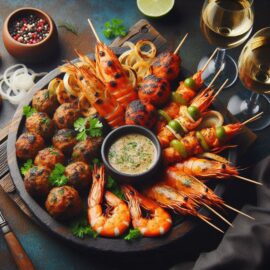Introduction
Few dishes showcase the bold spectrum of Indian tandoori cooking as beautifully as the Tandoori Mixed Grill. This sizzling platter of spiced, marinated meats and seafood celebrates fire, flavor, and finesse—and deserves a wine pairing that can hold its own against such intensity. Let’s explore how the science and art of wine pairing meet this iconic dish.
Tandoori Mixed Grill & Cultural Context
The Tandoori Mixed Grill is a North Indian culinary favorite, inspired by the centuries-old technique of cooking in a tandoor, a clay oven that imparts smokiness and char. Popular in Punjabi cuisine and widely adopted across India and abroad, this dish is often served as an appetizer platter or main course during festive gatherings. It’s a celebration of diversity on a plate—featuring tandoori chicken, lamb seekh kebab or chops, shrimp, and salmon.
Key Ingredients & Preparation Style
- Proteins: Chicken (often leg or breast), lamb (ribs or minced kebabs), shrimp, and salmon.
- Marinade: Yogurt, lemon juice, garlic, ginger, and a mix of spices like garam masala, cumin, coriander, turmeric, and Kashmiri red chili.
- Cooking Method: Traditionally roasted in a tandoor, resulting in charred edges and smoky depth.
Flavor & Texture Profile
- Spicy, smoky, tangy, and savory.
- Chicken and lamb deliver hearty, robust flavors.
- Shrimp and salmon are more delicate yet retain the intense marinade.
- Textures range from juicy and tender to crispy at the edges.
Science Behind Spice & Wine Interactions
- Acidity cuts through richness and balances the yogurt-based marinade.
- Tannins may clash with chili heat but complement charred meats when controlled.
- Sweetness helps tame heat, especially for shrimp and chicken.
- Alcohol can amplify spice—so lower alcohol is better unless offset by sweetness.
Spice Compounds to Consider:
- Capsaicin (chili heat): Enhanced by alcohol, soothed by sweetness or acidity.
- Turmeric & cumin: Can clash with oaky wines but harmonize with floral or spicy whites.
- Smoky char: Loves structured reds and aromatic whites.
Ideal Wine Pairings: Science & Art of Selection
White Wines
- Gewürztraminer (Alsace, France)
Why it Works: Aromatic, low acid, slightly off-dry—handles spice and complexity well.
Regions/Producers to Try: Domaine Weinbach (Alsace), Trimbach, or Pacific Rim (Washington State). - Riesling (Germany – Kabinett or Spätlese)
Why it Works: Sweetness cools heat, while acidity complements the yogurt marinade.
Regions/Producers to Try: Dr. Loosen, Selbach-Oster, or Nik Weis. - Grüner Veltliner (Austria)
Why it Works: Peppery notes match Indian spice; bright acidity cuts through richness.
Regions/Producers to Try: Domäne Wachau, Weingut Bründlmayer.
Red Wines
- Zinfandel (California)
Why it Works: Juicy, bold fruit with soft tannins; can handle smoky lamb and spicy chicken.
Regions/Producers to Try: Ridge Vineyards, Turley, Seghesio. - Gamay (Beaujolais Villages, France)
Why it Works: Light body, low tannins, vibrant red fruit—refreshing contrast to grilled shrimp and salmon.
Regions/Producers to Try: Domaine Dupeuble, Jean Foillard. - Pinot Noir (Oregon or New Zealand)
Why it Works: Earthy enough for lamb, fruity enough for shrimp—versatile and food-friendly.
Regions/Producers to Try: Elk Cove (Oregon), Ata Rangi (NZ), La Crema.
Unexpected Pairings: Lesser-Known but Great Choices
- Dry Lambrusco (Italy): Slightly fizzy, red-fruited, and refreshing with charred meat.
- Rosé of Tempranillo (Spain): Bright and bold enough for tandoori spice yet delicate enough for shrimp.
- Orange Wines: Tannic whites with extended skin contact—they mirror smoky, spiced complexity beautifully.
Wines to Avoid & Common Mistakes
- Heavy Tannic Reds (like young Cabernet Sauvignon): Amplify heat and clash with yogurt marinade.
- Oaked Chardonnay: Creamy oak may dull the spice and feel flabby next to the dish.
- High-Alcohol Reds: Intensify capsaicin burn.
Quick-Reference Table
| Mismatched Pairing | Why It Doesn’t Work | Better Alternative | Example Wine | Example Reason | Suggested Wine |
|---|---|---|---|---|---|
| Cabernet Sauvignon | Too tannic and heavy | Gamay | Napa Valley Cab | Tannins overwhelm spice | Beaujolais Villages |
| Oaked Chardonnay | Creamy texture dulls spice, lacks acidity | Riesling or Grüner | Sonoma Chardonnay | Oak clashes with cumin/turmeric | Alsace Riesling |
| Syrah/Shiraz (High ABV) | Alcohol intensifies chili heat | Gewürztraminer | Barossa Shiraz | Burn from spice amplified | Gewürztraminer |
Final Thoughts & Expert Tips
Key Takeaway: Pairing with tandoori is about harmony with heat, smoke, and complexity. Look for wines with bright acidity, low tannins, and aromatic profiles. Avoid overly oaky or tannic choices.
Fun Fact: The ancient clay tandoor has roots in the Indus Valley Civilization—making this pairing truly a mix of ancient and modern refinement.
Personal Tip: A chilled bottle of off-dry Riesling is my go-to for a tandoori platter—it keeps every bite exciting, whether it’s shrimp or lamb.
Recipe & Wine-Friendly Adjustments
Ingredients
- 1 lb chicken thighs, boneless
- 1 lb lamb chops or seekh kebabs
- 1/2 lb large shrimp, peeled
- 1/2 lb salmon fillet, cut into chunks
- 1 cup plain yogurt
- 2 tbsp lemon juice
- 1 tbsp ginger-garlic paste
- 2 tsp garam masala
- 1 tsp ground cumin
- 1 tsp turmeric
- 1 tsp Kashmiri chili powder
- Salt to taste
- Fresh cilantro, lemon wedges for garnish
Preparation
- Mix yogurt, lemon juice, spices, and salt to make marinade.
- Coat each protein separately and marinate 4–6 hours or overnight.
- Preheat grill or oven broiler.
- Skewer proteins or lay on a rack. Grill/broil until charred and cooked through.
- Serve hot with lemon wedges and cilantro.
Wine-Friendly Modifications
- Reduce chili powder slightly if you want to lean toward dry whites or reds.
- Add a bit of honey to the marinade if serving with a dry rosé or Lambrusco.
Serving Suggestions
- Plate proteins together on a sizzling tray.
- Serve with mint chutney, pickled onions, naan, and cucumber raita to cool the palate.
- Chill white wines or light reds slightly (55°F) for optimal pairing.

